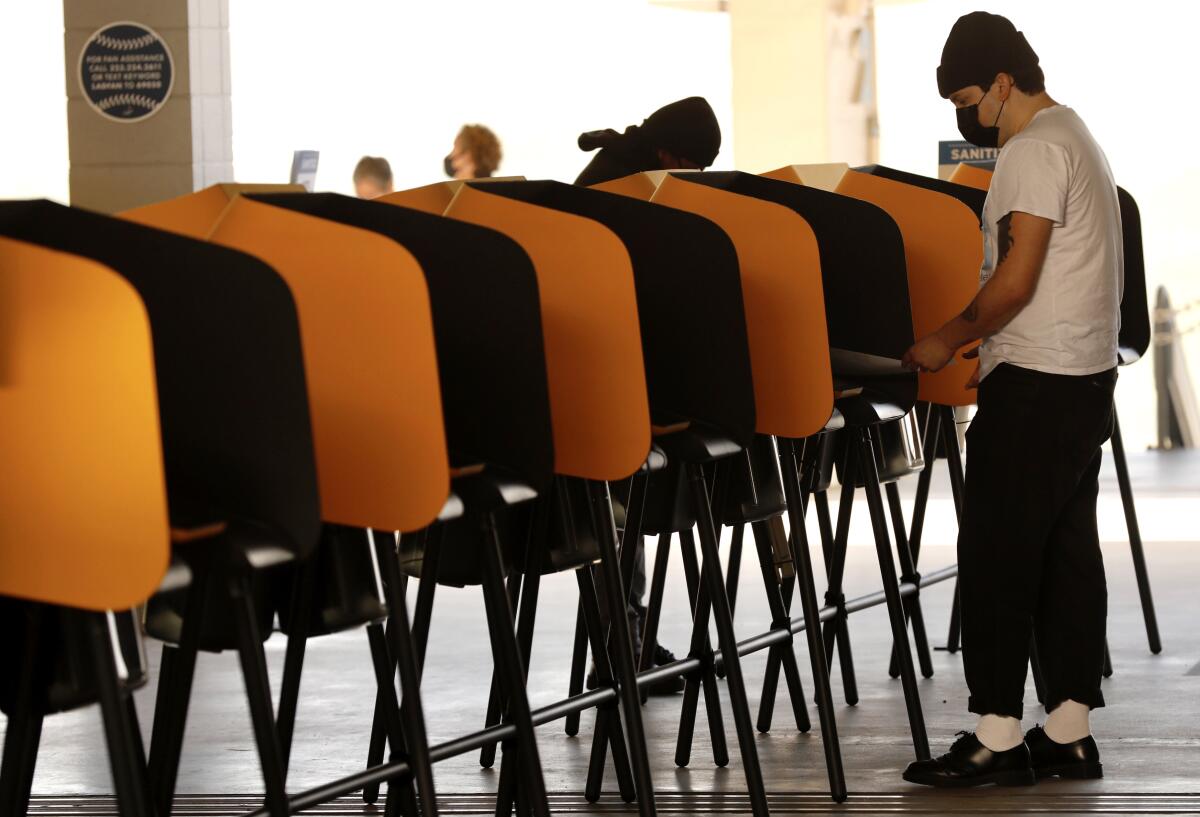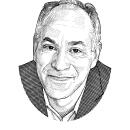A decade ago, California adopted a strange top-two primary system. How’s it working out?

- Share via
It’s no secret that we’re living in a moment of extraordinary political polarization and government dysfunction. Growing rancor, distrust and partisan disagreement among elected officials have led to an unwillingness to compromise or forge solutions to pressing policy challenges.
California, to its credit, recognized this way back in the early 2000s — yes, well before the presidency of Donald Trump — and took steps to combat it. One of those steps was the passage of Proposition 14, a 2010 ballot measure prompted more by gridlock in Sacramento than Washington, that rewrote how political primaries are held in congressional, statewide and state legislative races.
The “top-two primary” system created by Proposition 14 has now been in effect for a decade. It’s been tested in five elections — and we’re about to test it in a sixth when the next primary arrives on June 7.
Opinion Columnist
Nicholas Goldberg
Nicholas Goldberg served 11 years as editor of the editorial page and is a former editor of the Op-Ed page and Sunday Opinion section.
Now some reformers are calling for the top-two system, or some version of it, to be expanded to states throughout the country as part of the solution to the nation’s deepening division.
Yet social scientists are divided on whether the California experiment has succeeded or failed. And, uh, shouldn’t we know that before it gets adopted too broadly?
Let’s review.
Before Proposition 14, California held regular, old-fashioned partisan primaries in which voters from each party (plus, in some cases, independent voters) selected their preferred candidates. The winning candidates from each party primary then faced off in the general election.
But that system seemed, to some, to be exacerbating problems. It gave disproportionate influence to political parties. In some parts of the state, where one party or the other dominated, it seemed to make the general election meaningless because whoever won the primary was almost assured of victory in November.
Most important, it appeared to encourage the election of candidates on the ideological extremes, because the voters who turned out for primaries tended to come from the most partisan poles of their parties. The candidates who won were those who appealed to that segment of voters.
And that seemed only to add to the gridlock in lawmaking.
So with Proposition 14, California switched to a top-two, nonpartisan primary system. Now all candidates, regardless of party, run in the same primary, and all voters, regardless of party, may vote for any of them. The top two vote-getters then move on to the general election runoff.
Sometimes the two candidates who advance are a Democrat and a Republican, but in other cases, the runoff is a contest between two candidates from the same party. Thus the famous “Berman-Sherman” congressional election between Democratic Reps. Brad Sherman and Howard Berman in 2012. Or the 2018 U.S. Senate runoff between Dianne Feinstein and fellow Democrat Kevin de León.
The goals of Proposition 14 included making races more competitive, boosting turnout and expanding each voter’s choice of candidates.
The chief objective, though, is to force candidates to compete for all voters, not just their party’s most stalwart ideologues. It was hoped that would encourage political compromise and moderation, because in the primary, Republican candidates would have to appeal to Democratic voters and Democratic candidates to Republican voters. All the candidates would woo independents.
So what’s the verdict? Has top-two struck a powerful blow against polarization?
Answer: No one quite knows.
Consider the state Legislature. Yes, there are indications that Californians are significantly less dissatisfied with their legislators than they were. But is that due to top-two? California also reformed its redistricting system around the same time, made it easier to pass a state budget and revamped its rules on term limits. Any of those reforms could be behind Sacramento’s improved approval ratings.
Andrew Sinclair, a government professor at Claremont McKenna College who has studied top-two primaries since their inception, cautions that “these things are very hard to measure” and that a lot of people are “making strong statements on relatively little data.”
That said, he comes down in favor of top-two.
“Congress is really broken, and many state legislatures are too,” Sinclair said. “I’m cautiously optimistic that top-two was a good thing. In the category of things to try, the potential upsides outweigh the potential downsides.”
A study by Christian Grose, a political science professor at USC, found that members of Congress elected under top-two were slightly more moderate than the candidates who would probably have won under a closed primary system.
Another showed that legislators elected under top-two are much more likely to respond to letters from constituents from other parties than are legislators elected through partisan primaries.
“The people who are being elected are marginally less extreme and more willing to work with others,” Grose said.
Political scientist Thad Kousser at UC San Diego is more skeptical, noting that Proposition 14 overpromised and underdelivered.
Kousser also says California’s Legislature remains the most polarized in the country.
“Top-two has given voters more candidate choices in the primary and different choices in the November elections,” he said. “But it hasn’t changed who voters have elected or the type of candidate they’ve elected. It hasn’t been a silver bullet to end the march toward partisan polarization.”
It’s pretty clear that while Proposition 14 hasn’t hurt, and may have delivered modest benefits, it isn’t the game changer some had hoped for.
Maybe we should keep experimenting. Alaska this year will hold a top-four nonpartisan primary. That will be followed by a runoff in which the winner will be chosen by ranked choice voting (a complicated system in which voters rank candidates in order of preference).
The ultimate goal shouldn’t be to elect only centrist politicians; voters should be able to elect a Bernie Sanders if they want. It should be to incentivize elected officials, whatever their politics, to work cooperatively, negotiate with opponents and seek compromises on divisive issues.
That’s essential for democracy.
If top-two or top-four can do that, great. But I’m not yet persuaded.
More to Read
A cure for the common opinion
Get thought-provoking perspectives with our weekly newsletter.
You may occasionally receive promotional content from the Los Angeles Times.












